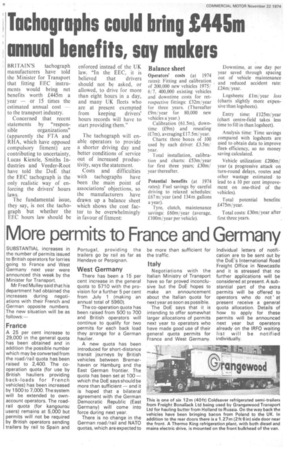Tachographs could bring £445m annual benefits, say makers
Page 20

If you've noticed an error in this article please click here to report it so we can fix it.
BRITAIN'S tachograph
manufacturers have told the Minister for Transport that fitting EEC instruments would bring net benefits worth £445m a year — or 15 times the estimated annual cost — to the transport industry.
Concerned that recent statements by "respon sible organizations" (apparently the ETA and RHA, which have opposed compulsory fitment) are contributing to uncertainty, Lucas Kienzle, Smiths Industries and Veeder-Root have told the DoE that the EEC tachograph is the only realistic way of enforcing the drivers' hours laws.
The fundamental issue, they say, is not the tachograph but whether the EEC hours law should be enforced instead of the UK law. "In the EEC, it is believed that drivers should not be asked, or allowed, to drive for more than eight hours in a day, and many UK fleets who are at present exempted from keeping drivers' hours records will have to start providing them."
The tachograph will enable operators to provide a shorter driving day and better conditions of service out of increased productivity, says the statement.
Costs and difficulties with tachographs have been the main point of associations' objections, so the manufacturers have drawn up a balance sheet which shows the cost factor to be overwhelmingly in favour of fitment:
Balance sheet
Operators' costs (at 1974 rates): Fitting and calibration of 200,000 new vehicles 1975/ 6/7, 400,000 existing vehicles and downtime costs for retrospective fittings: £32m/ year for three years. (Thereafter £9m/ year for 80,000 new vehicles a year.)
Calibration (61.5m), downtime (£9m) and resealing (£7m), averaging £ 17.5m; year.
Charts: three boxes of 100 used by each driver: £3.5m/ year.
Total installation, calibration and charts: £53m / year for first three years; £30m1 Year thereafter.
Potential benefits (at 1974 rates): Fuel savings by careful driving to relaxed schedules: £67 m/ year (and 134m gallons a year).
Tyre, clutch, maintenance savings: £60m/ year (average, 100m /year per vehicle).
Downtime, at one day per year saved through spacing out of vehicle maintenance and reduced accident rate: £24m/ year.
Logsheets: /Int/year loss (charts slightly more expensive than logsheets).
Entry time: £125m/year (chart centre-field takes less time to fill in than logsheet).
Analysis time: Time savings compared with logsheets are used to obtain data to improve fleets efficiency, so no money saving calculated.
Vehicle utilization: £200m/ year (a progressive attack on turn-round delays, routes and other wastage estimated to lead to a 10 per cent improvement on one-third of the vehicles).
Total potential benefits; £475m; year.
Total costs: £30m/ year after first three years.




















































































































